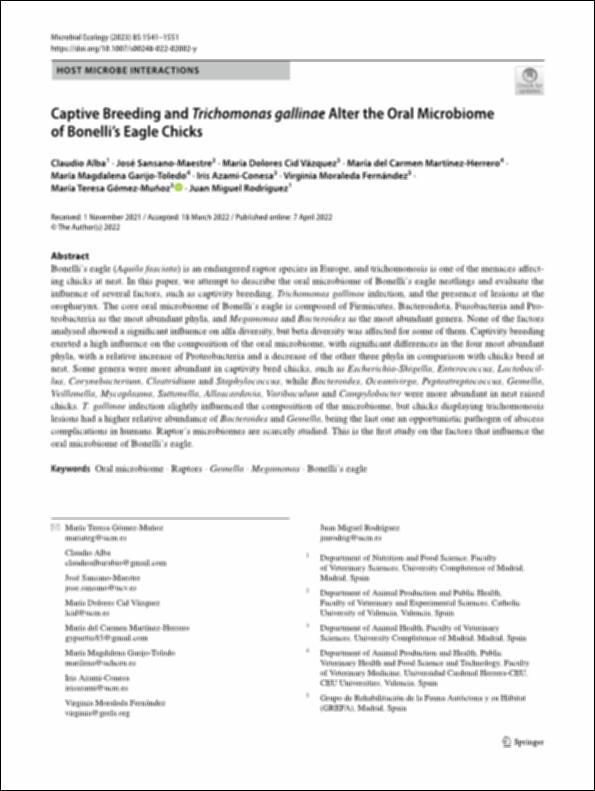Por favor, use este identificador para citar o enlazar este ítem:
http://hdl.handle.net/10637/14420Captive breeding and "Trichomonas gallinae" alter the oral microbiome of Bonelli's eagle chicks
| Título : | Captive breeding and "Trichomonas gallinae" alter the oral microbiome of Bonelli's eagle chicks |
| Autor : | Alba Rubio, Claudio Sansano Maestre, José Cid Vázquez, María Dolores Martínez Herrero, María del Carmen Garijo Toledo, María Magdalena Azami Conesa, Iris |
| Materias: | Eagles - Communicable diseases.; Águilas - Enfermedades parasitarias.; Trichomoniasis.; Trichomoniasis in eagles.; Águilas - Enfermedades infecciosas.; Tricomoniasis. |
| Editorial : | Springer Nature |
| Citación : | Alba, C., Sansano-Maestre, J., Cid Vázquez, M. D., Martínez-Herrero, M. D. C., Garijo-Toledo, M. M., Azami-Conesa, I., Moraleda Fernández, V., Gómez-Muñoz, M. T. & Rodríguez, J. M. (2023). Captive breeding and "Trichomonas gallinae" alter the oral microbiome of Bonelli's eagle chicks. Microbial Ecology, vol. 85, i. 4 (may.), pp. 1541–1551. DOI: https://doi.org/10.1007/s00248-022-02002-y |
| Resumen : | Bonelli’s eagle (Aquila fasciata) is an endangered raptor species in Europe, and trichomonosis is one of the menaces affecting chicks at nest. In this paper, we attempt to describe the oral microbiome of Bonelli’s eagle nestlings and evaluate the influence of several factors, such as captivity breeding, Trichomonas gallinae infection, and the presence of lesions at the oropharynx. The core oral microbiome of Bonelli’s eagle is composed of Firmicutes, Bacteroidota, Fusobacteria and Proteobacteria as the most abundant phyla, and Megamonas and Bacteroides as the most abundant genera. None of the factors analysed showed a significant influence on alfa diversity, but beta diversity was affected for some of them. Captivity breeding exerted a high influence on the composition of the oral microbiome, with significant differences in the four most abundant phyla, with a relative increase of Proteobacteria and a decrease of the other three phyla in comparison with chicks bred at nest. Some genera were more abundant in captivity bred chicks, such as Escherichia-Shigella, Enterococcus, Lactobacillus, Corynebacterium, Clostridium and Staphylococcus, while Bacteroides, Oceanivirga, Peptostreptococcus, Gemella, Veillonella, Mycoplasma, Suttonella, Alloscardovia, Varibaculum and Campylobacter were more abundant in nest raised chicks. T. gallinae infection slightly influenced the composition of the microbiome, but chicks displaying trichomonosis lesions had a higher relative abundance of Bacteroides and Gemella, being the last one an opportunistic pathogen of abscess complications in humans. Raptor’s microbiomes are scarcely studied. This is the first study on the factors that influence the oral microbiome of Bonelli’s eagle. |
| Descripción : | Este artículo se encuentra disponible en la siguiente URL: https://link.springer.com/article/10.1007/s00248-022-02002-y En este artículo de investigación también participan: Virginia Moraleda Fernández, María Teresa Gómez-Muñoz y Juan Miguel Rodríguez. |
| URI : | http://hdl.handle.net/10637/14420 |
| Derechos: | http://creativecommons.org/licenses/by/4.0/deed.es |
| ISSN : | 0095-3628 1432-184X (Electrónico) |
| Idioma: | es |
| Fecha de publicación : | 10-may-2023 |
| Centro : | Universidad Cardenal Herrera-CEU |
| Aparece en las colecciones: | Dpto. Producción y Sanidad Animal, Salud Pública Veterinaria y Ciencia y Tecnología de los Alimentos |
Los ítems de DSpace están protegidos por copyright, con todos los derechos reservados, a menos que se indique lo contrario.


